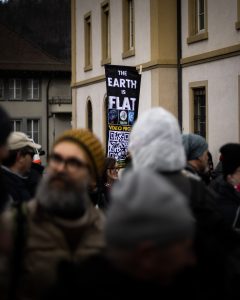Can critiques of lived experience transform the world? In recent years, proponents of “critical phenomenology” (e.g., Salamon 2018, Weiss et al. 2020) have articulated an affirmative answer that hinges on the function of “critique” within such a project. Here, I seek to think through their response to this question in the context of the present polycrisis, where disparate shocks interact and render than the overall impact far more severe the sum of each crisis.
I will take the recent Critical Phenomenology: An Introduction, by Elisa Magrì and Paddy McQueen (2023) as my reference point in assessing the project of critical phenomenology in a time of multiple overlapping crises. While conceding that phenomenology requires some form of critical sensibility, the coauthors distinguish “critical phenomenology” from “classical phenomenology” due to the former’s “sustained focus on the relation between self and social identity,” “the intersectional character of lived experience,” and “the critique of the natural attitude” (9). Obviously, not every self-described critical phenomenologist will necessarily take their account wholly to define their projects or theoretical self-understanding (see, e.g., Marder 2014, Aldea et al. 2022). Crucially, though, this text frames critical phenomenology as an ameliorative task as well as a descriptive one, echoing an earlier characterization of the subfield from an edited volume (22, Weiss et al. 2020: xiv). Hence, the question I want to explore with the text’s understanding of “critique” is the following: if the very biosphere we humans inhabit calls for radical, revolutionary projects of liberation, can an efficacious notion of critique that responds to these conditions be grounded in the modest task of “amelioration”?
In the present, one might rightly question the relevance of any phenomenology at this stage of capitalism and the multiple crises it underwrites. The imposed advent of generative “artificial intelligence” seems to make the prospect of phenomenological research, let alone a critical phenomenological project, seem outdated at best, or a mark of disciplinary decadence at worst. Especially for those committed to liberatory political projects, there is also a constant fear that any sufficiently radical idea or movement will, eventually if not immediately, become co-opted by the culture at large as its theoretical practice becomes ever more dissociated from the initial concrete conditions that prompted its initial theorization. And yet, the very existence of generative AI proves the permanence of the analog world, as coloniality remains a crucial component of the structuring logic for the production and operation of AI (see, e.g., Muldoon & Wu 2023, Muldoon et al. 2024). To paraphrase an oft-misattributed quote, there is indeed great disorder under the heavens, but declaring the current situation to be “excellent” seems either naïvely optimistic or just plain wrong.
Hence, one cannot but approach concepts such as the one under consideration with some bemusement: what is the critique offered by even a “critical phenomenology” while we are threatened with a series of increasingly deranged extractive regimes—whether digital or analog, financial or physical, administrative or affective—as the planet responds in kind by threatening ever more of us with fire, flood, famine, and (more) conflict over ever scarcer resources?
On the Very Idea of a Critical Phenomenology
Against these dire realities, many critical phenomenologists have explicated the necessity of phenomenological analysis for any putatively complete understanding of the human condition. In this respect, Magrì and McQueen have mustered an impressive introduction.

Magrì and McQueen begin their text by questioning the precise role of “critique” within “critical phenomenology” before moving into genealogical discussions of the themes most often explored across the various critical phenomenological projects in the field: corporeality, intersubjectivity, gender and sexuality, race, social experience, and political action. While there is a great deal to admire in the book, the first chapter on “critique” is what concerns me for present purposes and will be my primary focus.
Magrì and McQueen present Maurice Merleau-Ponty as the “first” critical phenomenologist, for combining his research in the Husserl Archives with Martin Heidegger’s hermeneutic phenomenology and Jean-Paul Sartre’s existential ontology to reformulate the phenomenological method into a style of thinking that examines the contours of one’s situated, lived experience (15–17). For the coauthors, then, it is the existential aspect of the phenomenological tradition that specifically works to “de-transcendentalize” its analyses of human subjective experience (but see Meagher 2021 for an alternative argument). “Critical phenomenology” thus positions itself with respect to the classical tradition in two ways: “as a critical appraisal of classical phenomenology and as a development of phenomenological discourse that centers on the critique of the presuppositions that surround the relations between power, embodiment, and social experience” (18). Indeed, on Magrì and McQueen’s account, most critical phenomenologists draw on the work of Merleau-Ponty, Frantz Fanon, and Simone de Beauvoir to advance their investigations into embodiment, social identity, and political action (19).
Drawing on Lisa Guenther’s Lévinas-inspired work, the coauthors further explicate that critical phenomenology is concerned with the realm of the “quasi-transcendental,” often through critical analysis of Husserl’s transcendental subjectivity—a move not only in keeping with “critique” as classically understood by Immanuel Kant or the research program of the Frankfurt School but also within the work of Jacques Derrida, himself concerned with problematizing the “transcendental” posited by the more idealist texts of Husserl or even orthodox Marxism (19–20). In fact, Magrì and McQueen repeat Theodor Adorno’s ad hominem criticism that Husserl “forsook an account of the material in historical conditions that affect human experience, privileging transcendental analysis over the critique of sociocultural norms,” because his transcendentalism was “indifferent to the socio-economic structures that condition historical reality, and whose acceptance cause the reproduction of the very power structures that inhere in ordinary experience” (20).
Interestingly, however, in distinguishing the normative ends of the Frankfurt School’s approach to critical social theory, the coauthors claim that “critical phenomenologists seek to understand how power structures affect perception, sensibility, and intersubjective experience, without necessarily using the normative lenses, deployed by critical theorist, such as Marxism, psychoanalysis, or speech acts” (22). Instead of being directed toward the ends of, say, total liberation from oppression or full reciprocal recognition, Magrì and McQueen see critical phenomenology as an “ameliorative project” that formulates “concepts and theories that expand our conceptual framework in order to improve its practical applications” (45). Despite this normative shift of the ends of critique, at least as understood by those working within the Marxist tradition, the coauthors maintain this aim is consistent with a positive project of building a more inclusive world that better accommodates difference and resists all forms of oppression and discrimination “through freeing individual experience from naturalized and normalizing presuppositions” (45–46).
Critique: Amelioration or Transformation?
Despite convincingly situating the critical phenomenological project as both an extension of and critical reflection upon earlier phenomenological investigations, I suspect the most contentious aspect of this admirable book will concern the work the term “critique” does in the coauthors’ idea of “critical phenomenology.” The book’s very brief discussions of Marxism and the Frankfurt School will likely be disappointing for scholars expecting a more thorough engagement with more explicitly Marxist strands of critical theory. Even a short chapter or excursus on the landscape of Francophone Marxist thought at the time of Sartre, Merleau-Ponty, de Beauvoir, and Fanon would have more clearly and accurately situated the relationship between critical phenomenology and Marxist critical theory.
In fairness, Magrì and McQueen provide citation-rich endnotes to document and fill in the details omitted in the larger presentation, which are essential for readers attempting to comprehend the development of relevant phenomenological concepts for scholarship and teaching. And of course, the text is an introduction to critical phenomenology rather than an exploration of the relationship between the then-powerful French Communist Party (PCF) and early “critical” phenomenologists. Certainly, whatever the precise relation, the latter were decidedly heterodox in their appropriation of Marxist thought in contrast to (often despite) the Soviet orthodoxy of the PCF. That is to say, the Marxist intellectual backdrop for French existential phenomenology is such a crucial part of its history—and thus a crucial part of the future practice of any critical phenomenology—that a fuller discussion feels necessary for its critical projects to succeed.
Moreover, eliding the undeniable historical relationship between Marxist theories of liberation and the phenomenological framework articulated by the coauthors of Critical Phenomenology prompts a question that merits serious consideration: why does “amelioration” emerge as the defining normative feature of a critical phenomenology rather than the aim of revolutionary liberation that so clearly informed the thinkers viewed as inaugurating “critical phenomenology”? Setting the normative end of social critique as “amelioration” seems to risk reducing the normative ambition of a social theory worthy of the name “critical,” in the sense understood by Kant or Max Horkheimer (or Fanon), to simple criticism. Certainly, “critical” can be broad enough to encompass both ameliorative and revolutionary ends, but to define critical phenomenology only in terms of the former suggests its theoretical scope is limited to what I will call “mere amelioration.” In other words, while the ameliorative project sketched by Magrì and McQueen and pursued by other critical phenomenologists may be broad enough to include liberation, framing all critical phenomenology in terms of amelioration may be at cross purposes with liberation. On such an account, critical phenomenology must ameliorate but need not liberate.
I push this point despite my admiration for the project of critical phenomenology and Critical Phenomenology as an introduction to the subdiscipline. But, as discussed earlier in this essay, the stakes of what counts as “critique” today are quite high. Indeed, beyond any quasi-millenarian concerns that utopian energies have been “exhausted” (Habermas 1986) or that critique is “running out of steam” (Latour 2004), all humanity is under direct existential threat from the unchecked ravages of a world-system dominated by shareholders of extractive industries backed (and defended) by militaristic nation-states. Given its emerging canon and the ameliorative project laid out in this book, I worry that the social and political vision of critical phenomenology is aimed solely at ameliorating the structural and material inequalities within presently existing neoliberal capitalism, even if such amelioration is not ultimately directed toward the end of total liberation demanded by critical theorists working within and in the spirit of the Marxist tradition.
Rather, I contend that a critical phenomenological investigation that works primarily to ameliorate would still seem to fall short of other forms of normative critiques (Marxist or otherwise) that aim for more than mere amelioration—that is, toward radically transforming or fundamentally altering total social relations in service to liberation or preserving the species. After all, it seems to me that the vertiginous perspicacity that phenomenology simpliciter offers the philosopher was well captured by Sartre’s declaration that Husserl restored “horror and charm” to the world (1939), a recognition that the human condition remains marked by contingency, despite the inherited ideas and embedded institutions we use to make meaning, guide action, and prepare for such contingencies. Such a radical phenomenological perspective, I suggest, is better suited for critically engaging with and thus reimagining our capital-dominated world than the relatively more restricted sense implied by “amelioration.” On the other hand, if human liberation is the ultimate normative end of critical phenomenology, as implied several times throughout the book, then it bears clarifying that the coauthors’ notion of “critical phenomenology” on its own is only ever—merely—ameliorative and can only be truly liberatory if it is also anti-capitalist.
This is not a theoretical quibble over normative preferences: indeed, in the current context of the overlapping and ongoing crises driven by petrostates maintaining imperial and colonial holdings as the climate continues to break down, it seems to me that any “critique” claiming to be “critical theory” today must necessarily be anti-capitalistic, if not Marxist. After all, Fanon reminds us that a Marxist analysis of colonialism must always be “slightly stretched” because the immediacy of the colonial context clarifies that “what divides this world first and foremost [is] what species, what race one belongs to” (1963: 5). Hence, there is “a kind of implicit correlation, a homogeneity” between colonial violence and “the insidious violence in which the modern world is steeped” (id. 40). But given Fanon’s central place as a canonical critical phenomenologist, it is strange the coauthors advocate an ameliorative approach that seemingly limits the lessons of the great theorist of revolutionary decolonial liberation (for an alternative approach, see Chapter 4 of Chaudhary 2024). If the goal is to articulate a critical phenomenology inspired by Fanon and other revolutionary thinkers, why reduce the theoretical scope and normative ambition of “critique” to mere amelioration when the greatest existential threat to humanity demands fundamental, radical global transformation to even ameliorate various ongoing ecocides and their respective fallouts?
In other words, what seems to be missing from much of the literature on critical phenomenology—subsequently reflected in Magrì and McQueen’s introduction—is the urgency evident in radical thinkers like Fanon (and others invoked as predecessors). Instead, the explicit methodological concerns for much critical phenomenology more clearly align with the ameliorative approach championed by liberal American pragmatism. This approach is certainly a progressive paradigm, especially by American political standards, but is amelioration really the properly critical approach to the species-wide threat posed by the global climatic emergencies that now condition and over-determine (if disparately) every lifeworld in this stage of neoliberal capitalism?
Hence, my admiration for Magrì and McQueen’s introduction to critical phenomenology is dimmed only by my disappointment that there was no clearer engagement with a politics of anti-capitalist liberation. (A lack of engagement that, ultimately, at least partially mirrors a deficit in the existing critical phenomenology literature the authors are surveying; see Popa and Reynolds 2021 for a similar criticism.) Even with my reservations about the notion of “critique” at play, I would likely still use this text to teach critical phenomenology—of course, no introduction can ever claim to give a complete presentation of its subject. But, one mark of an excellent introduction is its utility outside its subject area. And consistent with the pluralistic account of truth implied by the very idea of a critical phenomenology, Magrì and McQueen endorse the interdisciplinarity that renders phenomenology such a fruitful methodology for the spectrum of human sciences.
That said, my worry remains: so long as “critique” can remain merely ameliorative, it need never be “radical,” let alone “transformative” or “revolutionary,” despite our species’ presently-precarious future and thus the urgency of fundamentally altering our (still-colonial) world-system.
To summarize, Magrì and McQueen have succeeded in showing how phenomenology itself is not only capable of critical self-reflection but well positioned to stage these important discussions within its own traditions. With this book, the pedagogical question that remains is precisely the gauntlet thrown to phenomenology by critical phenomenologists: does the power of critique lie in ameliorating social pathologies or by radically altering the very material conditions that create those pathologies? Or, perhaps more polemically, yet no less accurately: once we have critiqued lived experience in this burning world, what is to be done?
Portions of this essay appeared earlier in the author’s review of Critical Phenomenology for Sartre Studies International.
The post Critical Phenomenology’s “Critique” in a Time of Polycrisis first appeared on Blog of the APA.
Read the full article which is published on APA Online (external link)




